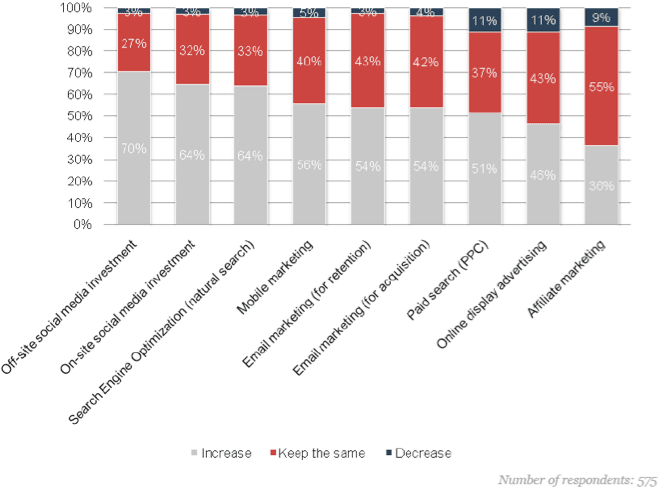Time to think again about display advertising?
I think it's fair to say that many don"€™t think of display advertising as the most powerful online communications technique. It consistently fairs poorly when marketers are asked to select their preferred tools and is known for low ad CTR rates. For example, see this Econsultancy research below on the most popular traffic-building techniques.
We were interested to hear your views on display advertising, this is what you replied - thanks to anyone who took a look!

Note on completing poll: In this poll display ads are any graphical, rich media or video ads excluding Google Adwords text ads or similar. Display ads may be placed through direct media buys, ad networks or through the Google Display (content) Network.
2010 preferences for different online marketing

Source: Variation in different digital marketing tactic used 2009-2010. Source: Econsultancy. Feb 2010.
See summary of marketing budget allocation report.
So why should we consider display advertising?
Despite its relative unpopularity, perhaps because of perceptions of high cost or low ad clickthrough rate there are a whole host of reasons why display advertising should at least have consideration within the mix.
Here are 10 reasons why you should consider display advertising. Which do you think are the 3 biggest benefits that justify display advertising for your company?
1. Generates awareness of your brand, or a new product or service. Success in Google Adwords often requires someone to be aware of a need to be searching for a known product or service. So it"€™s hard to make someone aware unless they already know what they're looking for - they have a defined need.
2. Display can be used for measured, direct response advertising. Display is not just about generating awareness, it"€™s used for direct response by many.
3. Display has a brand halo-effect. The relatively low clickthrough rates of display advertising are a distinct disadvantage in comparison with other direct media, but research using digital advertising attribution modeling shows that display can definitely generate interest by boosting site visits and searches for a brand.
4. Gives additional reach to different audiences compared to other online media. There is a finite inventory in paid search; there"€™s only so many keywords you can buy against, even if you could afford to, so display gives an alternative.
5. Gives additional reach to different audiences compared to other offline media. Similarly, if you invest in offline media like print or TV advertising, you can reach a level where additional investment in advertising doesn"€™t give you better results because you have reached saturation. Increasing display has been shown to give better results.
6. The cost of display advertising has fallen with new buying models in place. With the cost of display advertising remaining high due to bidding competition, there are now cheaper purchase options with many using pay per click rather than high-cost cost per thousand deals where there is wastage.
7. Integration with social media. Did you know that for big brands, the majority of Likes are generated by advertising within Facebook. Likewise you can also advertise in Linked In, with Twitter offering more options soon.
8. New ad formats. As we said before, it"€™s not just the old 468X60 banner. Other formats such as the 320 by 250 rectangle the tend to work better.
9. New targeting options like behavioural retargeting. These are not that new, but have previously been only available to larger advertisers. These are now more affordable and accessible to all advertisers.
10. Options to test, learn and refine creative. As with other online media like pay-per-click ads, there are good options to learn about which messages and which creative works best. We can measure not only the proportion of people who click on our ads (clickthrough rates), but also the proportion who interact with the ads (interaction rate).
So there are a compelling set of reasons why you should consider or reconsider display advertising, but you need to be aware of the key disadvantages.
So why isn"€™t everyone using display advertising?
1. Relatively low click-through rates. This is the big challenge. When discussing online ads, many web users will state they ignore ads and find them intrusive. Published click-through rates support this, with most compilations showing response rates of around 0.1 to 0.2%, but with rich media formats such as video ads attracting higher click-through rates. This phenomenon is known among practitioners as banner blindness (see for example, Nielsen (2007). The first 468 * 68 pixel banner ad was placed on Hotwired in 1995 and the call-to-action "€˜Click here!"€™ generated a clickthrough of 25%. Since then, the click-through rate (CTR) has fallen dramatically with many consumers suffering from "€˜banner blindness"€™ "€“ they ignore anything on a website that looks like an ad. Remember though, that for reasons such as awareness generation and the media multiplier effect, digital marketers should not dismiss online advertising as ineffectual based on click-through rates alone. Figure 9.10 shows a more recent compilation.
2. Relatively high costs or low efficiency. When the low response rates are combined with relatively high costs of over £10 per thousand, this makes online ads an inefficient medium.
3. Brand reputation on display ad networks. Brands can potentially be damaged in the consumers"€™ mind if they are associated with some types of content such as gambling, pornography or racism. It is difficult to monitor precisely which content an ad is served next to when millions of impressions are bought across many sites, this is particularly the case when using ad networks.






